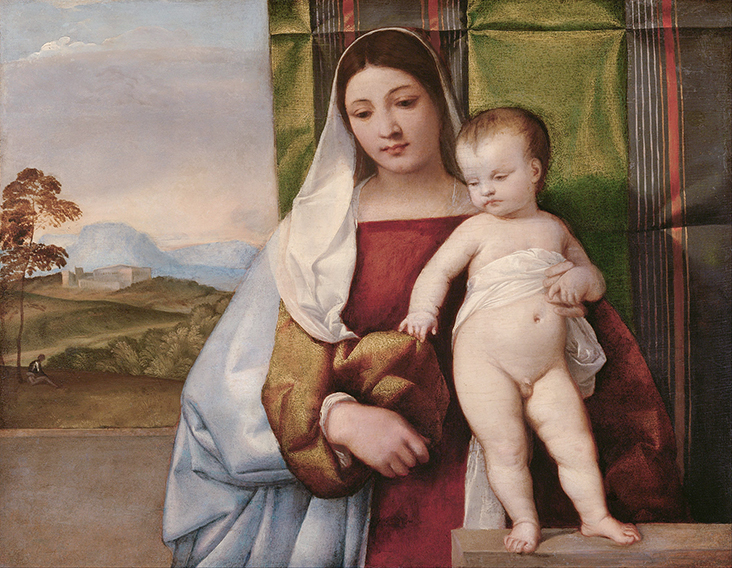FS Colour Series: English Rose inspired by Titian’s Passionate Crimson
ENGLISH ROSE linen’s sumptuous, rustic crimson held great spiritual significance during the Italian Renaissance, clothing figures with indulgent drapes that seem to radiate human warmth. For centuries the colour red was deeply devotional, reserved for Christ, the Virgin Mary and their close circle, symbolising the love, passion and spilt blood of their shared tragedy. But by the Mannerist stage of the High Renaissance artists were expanding this loaded colour into new territory. World famous Venetian master Titian painted religious, secular and mythological subjects with this gloriously vibrant red tone; given how rare, expensive and potentially toxic the pigment was he placed it sparingly on the canvas, adding intensity and drama around his central and most prized figures. “A good painter needs only three colours,” he mused, “…black, white, and red.”
Titian was born Tiziano Vecellio in the small village of Pieve di Cadore in the Itialian Alps. At the tender age of 9 he was sent to Venice with his older brother to train as a painter under Sebastiano Zuccato, where he learned to paint in fresco and oil, later moving on to study with Gentile Bellini. After befriending Giorgione, Titian began emulating his style, painting with the same vivid colours and dramatic lighting as his elder, even completing many of Giorgione’s paintings after he died prematurely of the plague aged 33. In his early works Titian focussed primarily on religious subjects, producing commissioned frescoes on a huge scale, as well as smaller oil panels which he hoped would sell to private homeowners in Italy, echoing the fashion for green and red interiors in his panel paintings. Gypsy Madonna, 1510, whose title alludes to Mary’s dark eyes and hair, is one such example, positioning the mother and child in a tender, informal moment amidst a lush green space. Her dress is punctuated by a deep, intense red that seems to permeate into the darkest depths of the canvas, suggestive of the foreboding future to come. Art historian Sidney J. Freedburg praised Titian’s virtuoso skill in this work, made when he had just turned 21, praising its remarkable way of “…reflecting coloured light but also absorbing it to saturation point, so that each pore of flesh or drapery makes texture.”
As Titian’s reputation grew, so too did his confidence, as we see in freer handling of paint, bolder colour choices and increasingly daring subject matter. In The Three Ages of Man, 1512-14 he abandons religious subject matter, choosing instead his own allegorical allusions to three stages of life; childhood, adulthood and old age/death. The young adult couple gaze adoringly into each other’s eyes while sensuous red clothing flows around the woman’s lower body, reflecting the heat of passion between the two young lovers. Two years later, Titian was appointed official painter of the Republic of Venice, a position he would hold for the next 60 years.
In The Annunciation, 1519-20, made for the interior of the Cathedral of Treviso in Northern Italy, Titian reveals his mastery in capturing the luminosity of surface texture as silky fabric, cold stone and feathered wings seem tangibly real. The Virgin Mary’s blue shawl becomes as light as air, shimmering in the sunlight, while contrasting warm, deep crimson spills out across the floor under it like a pool of blood, lending the work gothic drama and weight. Christ the Redeemer, 1533 – 1534, is quieter and more intimate, a private commission for Francesco Maria della Rovere, Duke of Urbino, portraying Christ as a gentle, pensive figure who gazes into the distance with a calm fortitude as if contemplating his inevitable fate. Surrounded by deep, melancholic blues, a pinkish red l-shape punctuates the darkness and draws us in towards a wide v around his heart-space, the place where blood pulses and love emanates.
Such was the success of Titian’s career in his later years, King Philip II of Spain gave him complete freedom to paint a series of large canvases; rising to the challenge, Titian produced a suite of seven paintings portraying mythological legends, or ‘poesie’, which are now considered the most accomplished of his entire career. Within the series is the world famous Diana and Actaeon, 1556-59, capturing the moment when the intrepid hunter Actaeon unwittingly stumbles across Goddess Diana’s bathing place; as punishment for seeing her naked body she transforms him into a stag who is hunted and killed by his own dogs. Flares of rose red fabric fall before Actaeon and under Diana’s seat, heightening the passionate, erotic charge between the two central characters, suspended here forever in time.

















































One Comment
Vicki Lang
Once again you have brought the artist alive with your words, along with the beautiful paints of the artist. Thank you.